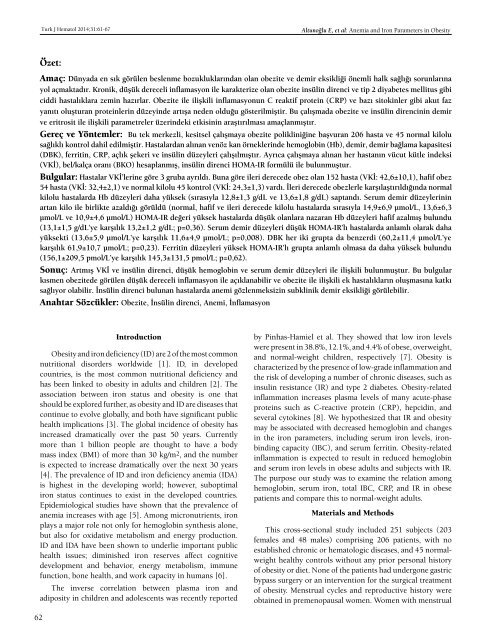Turkish Journal of Hematology Volume: 31 - Issue: 1
Create successful ePaper yourself
Turn your PDF publications into a flip-book with our unique Google optimized e-Paper software.
Turk J Hematol 2014;<strong>31</strong>:61-67<br />
Altunoğlu E, et al: Anemia and Iron Parameters in Obesity<br />
Özet:<br />
Amaç: Dünyada en sık görülen beslenme bozukluklarından olan obezite ve demir eksikliği önemli halk sağlığı sorunlarına<br />
yol açmaktadır. Kronik, düşük dereceli inflamasyon ile karakterize olan obezite insülin direnci ve tip 2 diyabetes mellitus gibi<br />
ciddi hastalıklara zemin hazırlar. Obezite ile ilişkili inflamasyonun C reaktif protein (CRP) ve bazı sitokinler gibi akut faz<br />
yanıtı oluşturan proteinlerin düzeyinde artışa neden olduğu gösterilmiştir. Bu çalışmada obezite ve insülin direncinin demir<br />
ve eritrosit ile ilişkili parametreler üzerindeki etkisinin araştırılması amaçlanmıştır.<br />
Gereç ve Yöntemler: Bu tek merkezli, kesitsel çalışmaya obezite polikliniğine başvuran 206 hasta ve 45 normal kilolu<br />
sağlıklı kontrol dahil edilmiştir. Hastalardan alınan venöz kan örneklerinde hemoglobin (Hb), demir, demir bağlama kapasitesi<br />
(DBK), ferritin, CRP, açlık şekeri ve insülin düzeyleri çalışılmıştır. Ayrıca çalışmaya alınan her hastanın vücut kütle indeksi<br />
(VKİ), bel/kalça oranı (BKO) hesaplanmış, insülin direnci HOMA-IR formülü ile bulunmuştur.<br />
Bulgular: Hastalar VKİ’lerine göre 3 gruba ayrıldı. Buna göre ileri derecede obez olan 152 hasta (VKİ: 42,6±10,1), hafif obez<br />
54 hasta (VKİ: 32,4±2,1) ve normal kilolu 45 kontrol (VKİ: 24,3±1,3) vardı. İleri derecede obezlerle karşılaştırıldığında normal<br />
kilolu hastalarda Hb düzeyleri daha yüksek (sırasıyla 12,8±1,3 g/dL ve 13,6±1,8 g/dL) saptandı. Serum demir düzeylerinin<br />
artan kilo ile birlikte azaldığı görüldü (normal, hafif ve ileri derecede kilolu hastalarda sırasıyla 14,9±6,9 µmol/L, 13,6±6,3<br />
µmol/L ve 10,9±4,6 µmol/L) HOMA-IR değeri yüksek hastalarda düşük olanlara nazaran Hb düzeyleri hafif azalmış bulundu<br />
(13,1±1,5 g/dL’ye karşılık 13,2±1,2 g/dL; p=0,36). Serum demir düzeyleri düşük HOMA-IR’lı hastalarda anlamlı olarak daha<br />
yüksekti (13,6±5,9 µmol/L’ye karşılık 11,6±4,9 µmol/L; p=0,008). DBK her iki grupta da benzerdi (60,2±11,4 µmol/L’ye<br />
karşılık 61,9±10,7 µmol/L; p=0,23). Ferritin düzeyleri yüksek HOMA-IR’lı grupta anlamlı olmasa da daha yüksek bulundu<br />
(156,1±209,5 pmol/L’ye karşılık 145,3±1<strong>31</strong>,5 pmol/L; p=0,62).<br />
Sonuç: Artmış VKİ ve insülin direnci, düşük hemoglobin ve serum demir düzeyleri ile ilişkili bulunmuştur. Bu bulgular<br />
kısmen obezitede görülen düşük dereceli inflamasyon ile açıklanabilir ve obezite ile ilişkili ek hastalıkların oluşmasına katkı<br />
sağlıyor olabilir. İnsülin direnci bulunan hastalarda anemi gözlenmeksizin subklinik demir eksikliği görülebilir.<br />
Anahtar Sözcükler: Obezite, İnsülin direnci, Anemi, İnflamasyon<br />
Introduction<br />
Obesity and iron deficiency (ID) are 2 <strong>of</strong> the most common<br />
nutritional disorders worldwide [1]. ID, in developed<br />
countries, is the most common nutritional deficiency and<br />
has been linked to obesity in adults and children [2]. The<br />
association between iron status and obesity is one that<br />
should be explored further, as obesity and ID are diseases that<br />
continue to evolve globally, and both have significant public<br />
health implications [3]. The global incidence <strong>of</strong> obesity has<br />
increased dramatically over the past 50 years. Currently<br />
more than 1 billion people are thought to have a body<br />
mass index (BMI) <strong>of</strong> more than 30 kg/m2, and the number<br />
is expected to increase dramatically over the next 30 years<br />
[4]. The prevalence <strong>of</strong> ID and iron deficiency anemia (IDA)<br />
is highest in the developing world; however, suboptimal<br />
iron status continues to exist in the developed countries.<br />
Epidemiological studies have shown that the prevalence <strong>of</strong><br />
anemia increases with age [5]. Among micronutrients, iron<br />
plays a major role not only for hemoglobin synthesis alone,<br />
but also for oxidative metabolism and energy production.<br />
ID and IDA have been shown to underlie important public<br />
health issues; diminished iron reserves affect cognitive<br />
development and behavior, energy metabolism, immune<br />
function, bone health, and work capacity in humans [6].<br />
The inverse correlation between plasma iron and<br />
adiposity in children and adolescents was recently reported<br />
by Pinhas-Hamiel et al. They showed that low iron levels<br />
were present in 38.8%, 12.1%, and 4.4% <strong>of</strong> obese, overweight,<br />
and normal-weight children, respectively [7]. Obesity is<br />
characterized by the presence <strong>of</strong> low-grade inflammation and<br />
the risk <strong>of</strong> developing a number <strong>of</strong> chronic diseases, such as<br />
insulin resistance (IR) and type 2 diabetes. Obesity-related<br />
inflammation increases plasma levels <strong>of</strong> many acute-phase<br />
proteins such as C-reactive protein (CRP), hepcidin, and<br />
several cytokines [8]. We hypothesized that IR and obesity<br />
may be associated with decreased hemoglobin and changes<br />
in the iron parameters, including serum iron levels, ironbinding<br />
capacity (IBC), and serum ferritin. Obesity-related<br />
inflammation is expected to result in reduced hemoglobin<br />
and serum iron levels in obese adults and subjects with IR.<br />
The purpose our study was to examine the relation among<br />
hemoglobin, serum iron, total IBC, CRP, and IR in obese<br />
patients and compare this to normal-weight adults.<br />
Materials and Methods<br />
This cross-sectional study included 251 subjects (203<br />
females and 48 males) comprising 206 patients, with no<br />
established chronic or hematologic diseases, and 45 normalweight<br />
healthy controls without any prior personal history<br />
<strong>of</strong> obesity or diet. None <strong>of</strong> the patients had undergone gastric<br />
bypass surgery or an intervention for the surgical treatment<br />
<strong>of</strong> obesity. Menstrual cycles and reproductive history were<br />
obtained in premenopausal women. Women with menstrual<br />
62

















